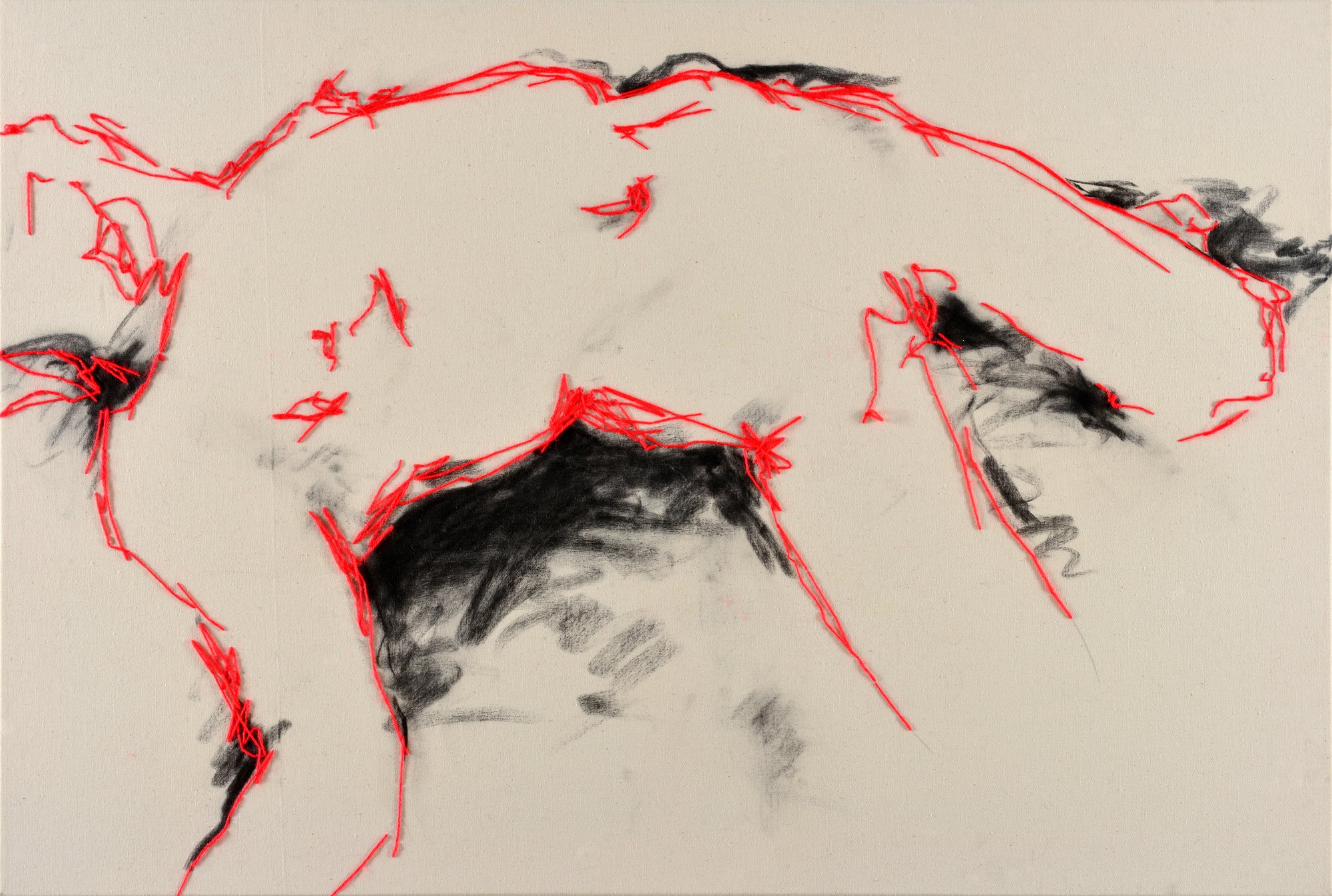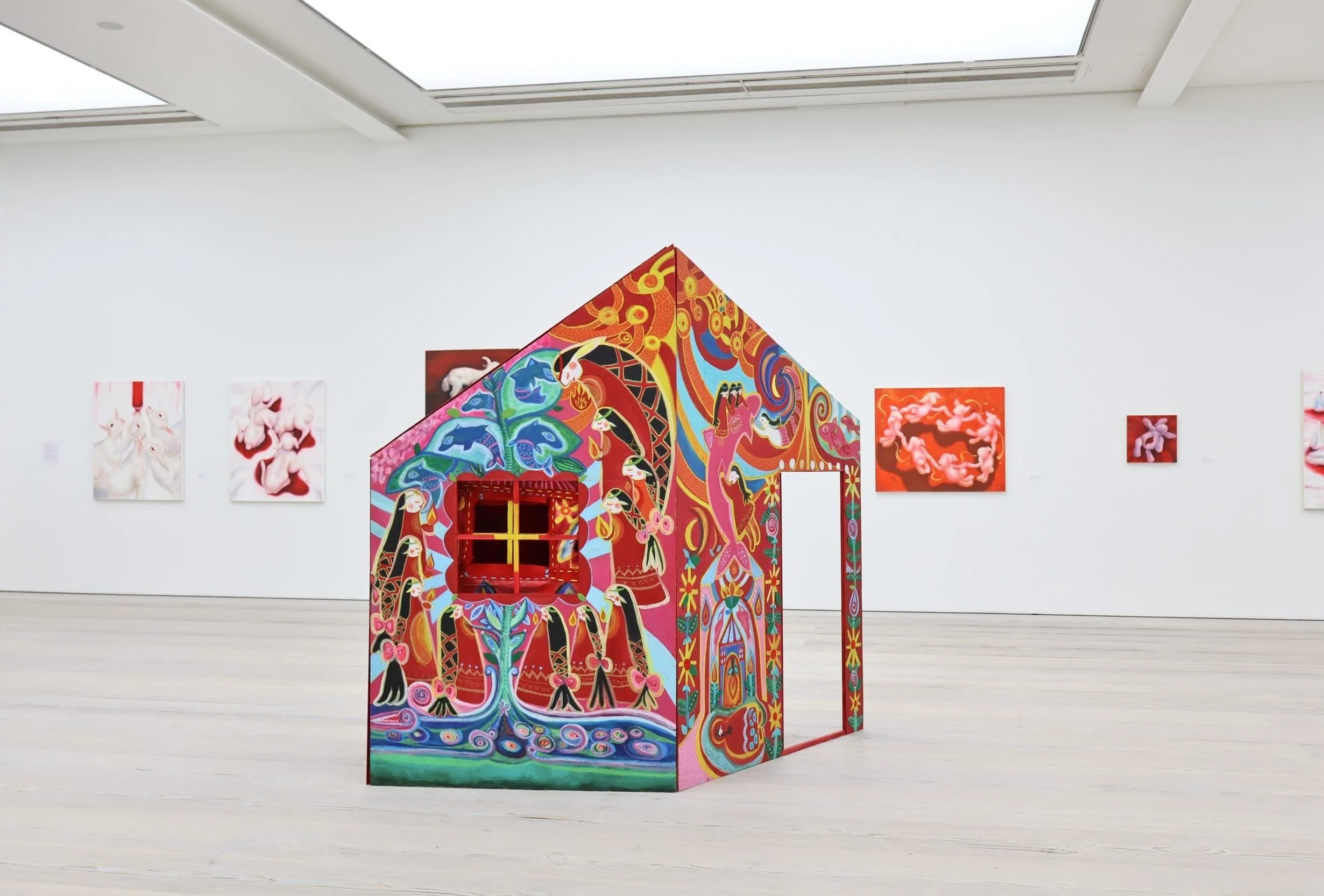10 Questions with Judit Bodrogi
Judit Bodrogi, a textile artist from Budapest, uses yarn like other artists use their pencils, drawing on canvas with needle and yarn.
Her pictures present the pressures placed on us by our own society. Throughout our lives, we are haunted by the feeling that we have to comply with certain expectations. We have to think, feel, and behave in a certain situation as expected by society. Judit often deals with these deep topics through her own emotions, working and processing her own traumas throughout the art.
Her main goal is to be able to transform a deep emotion into a human gesture and to present these fleeting moments with embroidery that lasts for days or weeks. It is this interesting contrast and connection between the moment and the long, monotonous work that drives her art.
Judit Bodrogi - Portrait
The need to conform has long stifled her art, and embroidery has helped her break through this. It simply made her angry that it was such a rule-bound system (if you stick the needle here, then do this and pull the thread like this, then this is the name of the stitch, and the little flower is done). She decided to break the established method completely and make her own rules. She left behind the constraints of creating the way other people are used to: the canvas is a big blank canvas; you can stick the needle anywhere, knot the needle, paint the thread, and do anything you want.
The composition often gives a surprising, even sloppy, feeling that some figures' hands or parts of their bodies are hanging off the picture; this is because the moments she is capturing are also not composed; she does not feel the need to place a reclining figure in the geometric center of the composition, she sees the emotion or trauma she wants to portray from her own perspective.
Her pictures are colorful, light, and beautiful to get lost and enjoy the view, but if you look at them closely, you will find a lot of pain. Happiness and pain also go hand in hand in our lives, so both layers are present in her paintings at the same time.
I WILL GET ON MY FEET, yarn, oil pastel, 45x105 cm, 2023 © Judit Bodrogi
INTERVIEW
First of all, tell our readers a little bit about you. Who are you, and how did you start experimenting with images?
I’m a textile artist living and working in Budapest, Hungary, but the way I became one is not the one I’d call usual, especially in Hungary. Looking back, I would say I always knew this was something that I had in me, but especially in the years after high school, my surroundings made me feel like I got to choose another avenue in life. For a couple of years, I didn’t create art, and that was as if I weren’t actually living. It’s during this soul searching that I found my expressive medium, yarn, and that was such a revelation: since this point, this is what fills up every one of my days, and I strive to become a better artist. I truly love what I do.
What is your personal aim as an artist?
If they are honest with themselves, every artist’s goal is to get into galleries, go to fairs and expos, exhibiting in gorgeous places, but apart from that, a constant goal I have is to push my limits further. To overcome my inhibitions, to accept and experience all my emotions through the act of creation.
CALVARY, yarn, acrylic, 140x80 cm, 2023 © Judit Bodrogi
AGONY, yarn, acrylic, 130x70 cm, 2023 © Judit Bodrogi
Your works use a very specific technique. Can you tell us about your creative process? What aspect of your work do you pay particular attention to?
Yes, my technique really is unique, and one that needed a lot of experimentation to get to the exact process that results in a piece that I’m actually proud of; as I’m a perfectionist, I only present works that are of the highest quality. Long story short, I’d summarize it as ‘drawing with yarn’ as opposed to traditional embroidery. It all hangs on the first part, which is also the hardest for me: sketching. If I can’t shut out the outside world, I can’t draw. In contrast, the embroidery comes much easier, even if I have several things rushing through my head: it takes longer. However, it’s also a relaxing, peaceful process.
You work primarily with threads. How did you come up with this concept? And how did you develop your style?
For the longest time, I thought I didn’t have what it takes to be an artist, only creating meaningless pieces that were pretty but not up to the standards I wanted to achieve. Then, during one Christmas break, my grandmother taught me embroidery. For a couple of weeks, I followed her instructions, doing the usual basic designs of flowers and leaves… but after a while, this closed system wasn’t enough for me. I had to take control: I have this large blank canvas; who told me I could only put tiny flowers on it? Then it all clicked: this was the material I could express myself with! This was my time to experiment, not just in style, but it was also a journey to discover myself and my vision.
ABUSE, yarn, acrylic, 105x70 cm, 2023 © Judit Bodrogi
Speaking of style, do you have any recurring element or color you always incorporate into your pieces? And what does it represent for you?
I tend to use bright and cheerful colors, but I wouldn’t say I prefer one over the others. Colors obviously have an important meaning; however, in my works, I try to subvert this by showing deep emotions and divisive subject matters while having an air of light and a breezy tone. This is symbolic of our lives: there’s pain and suffering but also beauty and joy. This is what my color scheme represents.
What messages would you like to convey with your art?
To be ourselves, to dare to be somebody, and not let anyone oppress or change us in a way we don’t want. Everybody in this world is different, and that’s what makes it so wonderful. We shouldn’t ever feel guilty about not conforming to society’s expectations and standards.
NUMBE ONE, yarn, oil pastel, 85x85 cm, 2023 © Judit Bodrogi
SEGNATURA, yarn, charcoal, 60x90 cm, 2023 © Judit Bodrogi
Where do you draw inspiration? Do you have any specific references?
That’s something that is ever-changing: sometimes it’s just a word that I like as a title, and from that, I build the concept. Other times, something happens to me that I have to tell. Society’s attitude to certain subjects and my despair over it are also things that inspire me: I have to talk about it, and this is my way of doing it. My models are usually my friends, but it’s also not unusual to use reference images or just do it freehand, without references.
What is your favorite experience as an artist so far?
As the Hungarian saying goes, I “still have the eggshell on.” I’m at the beginning of my journey as a professional artist, so I don’t yet have a vast collection of anecdotes. However, I won’t ever forget the first time I got pictures in a gallery: the moment when the doors opened and the people came streaming in, walking around, stopping in front of my picture and chatting about it. It was an unfathomable feeling.
YOU ARE HUNDRED, I AM ALONE, yarn, acrylic, 95x70 cm, 2023 © Judit Bodrogi
What are you working on now, and what are your plans for the future? Anything exciting you can tell us about?
I’m working on some larger pieces, as I think my technique creates a more interesting image when blown up on a bigger canvas. As for the not-so-immediate future, I’d like to abstract my shapes further, pushing myself to let things go and not obsess about perceived perfection. Another plan of mine is to create an installation that leaps off the canvas and goes into the third dimension. However, this one is quite far out yet; maybe I’ll realize these ideas in a future exhibition.
Lastly, what is the biggest goal you have for 2024?
My greatest goal this year is an international expo. I’d like to get out of my shell, that is, the Hungarian scene, to meet foreign artists and curators, and to find friends across the world. I’d like to have a solo exposition this year; I enjoy the organizational and background aspects of the art world, not just the creation; this is also a field I’d like to try myself in.
Artist’s Talk
Al-Tiba9 Interviews is a promotional platform for artists to articulate their vision and engage them with our diverse readership through a published art dialogue. The artists are interviewed by Mohamed Benhadj, the founder & curator of Al-Tiba9, to highlight their artistic careers and introduce them to the international contemporary art scene across our vast network of museums, galleries, art professionals, art dealers, collectors, and art lovers across the globe.






















